Brief
 }
}
At a recent meeting that brought together utilities executives from around the world with Silicon Valley energy innovators, attendees were discussing, among other topics, the state of energy storage. One utility executive asked the Silicon Valley hosts when they expected to see utility-scale storage deployed broadly. “Oh, not for a long time,” one of the new energy executives replied, “maybe 2019.”
For the stunned utility executives, most of whom think of a “long time” as decades, the remark was a wake-up call to the pace at which new ideas and technologies are disrupting their industry. Today, most of the electricity sector lags behind the progress that other sectors have made in digitalization, customer engagement and the everyday use of advanced analytics to generate value from data. But change is beginning to unfold quickly, and it’s now clear that the sector will look dramatically different in a decade or so.
Some of those differences will improve operations, such as the new data-analytic capabilities that one North American utility is using to improve its accuracy in forecasting the duration of power outages. Others will happen “beyond the meter,” with new products and services designed to make life easier for customers—a task that will be no small trick for executives who have sometimes referred to their customers as “meter points.” These are only a few of the hundreds of opportunities developing as the potential of digitalization dawns on the industry.
Utility executives know the direction that change will take, and they are beginning to see what their industry will look like as this transformation takes root. But while the direction is known, the pace is less certain—and probably more rapid than most executives are anticipating. In the interim, executives are beginning to grapple with the challenges of this transition, and many are identifying the opportunities.
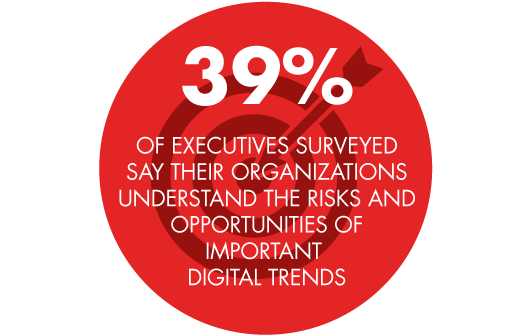
What creates digital success?
With all this in mind, how should utility executives determine their digital strategy? While every company’s situation is unique, we see some common themes to successful digital strategies.
- Establish a clear view of the industry’s direction over the next 5, 10 or 15 years. The end game is knowable, even if the pace of change is not.
- Start with an honest assessment of your company’s point of departure, and a clear vision for where you are trying to go.
- Harness the energy of the entire team and organization: the pragmatism of the doers and the passion of the dreamers.
- Take concrete steps now to build new offerings (the what) and new capabilities (the who and the how).
Establish a view on the industry’s direction
Some of the most intriguing opportunities in the electricity sector are in services and products beyond the meter, where consumers interact with their energy use. Consumer services will require an entirely new set of capabilities that many utilities have not adequately developed. Success in this domain will probably require partnerships with new energy companies that have emerged without the legacy and regulatory issues that can slow down utilities. Most of these new companies have demonstrated their ability to design and market services from the customer perspective outwards.
Moreover, utility executives could miss critical innovations if they look only at their own sector. The clearest example of this is the innovation in the automotive sector that will have an enormous impact on utilities: as electric vehicles (EVs) become more popular, the experience curve in making their batteries will enable cost-effective energy storage at a utility scale, far quicker than if the utility sector were left to bring down those costs on its own.
With these opportunities in mind, where should utility executives focus their efforts and deploy capital in pursuit of the most fruitful opportunities? According to Bain’s analysis of the investment within utilities and among new energy insurgents, six digital themes within three categories (assets, operations, customers) appear to be more important and promising than others (see Figure 1).
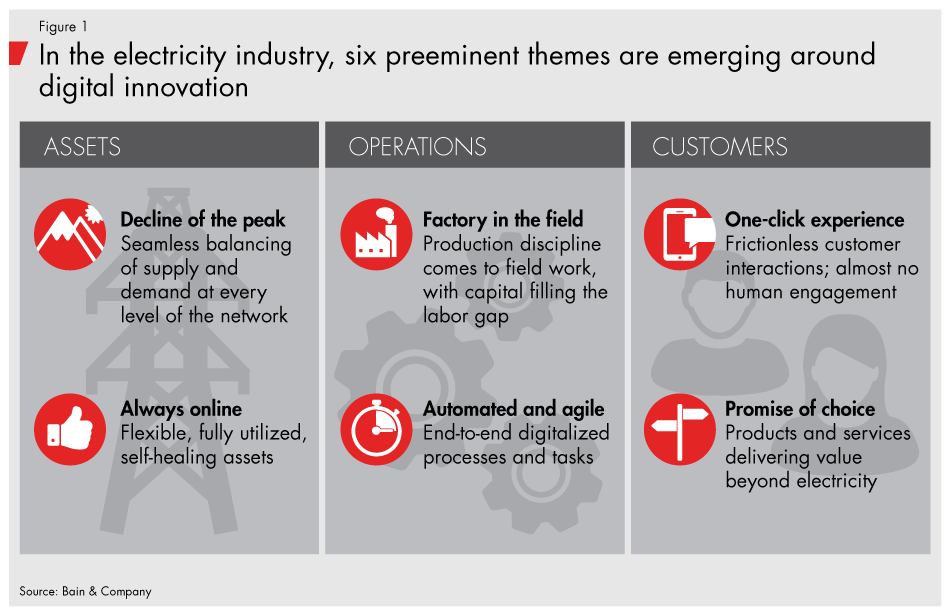
Assets
- Decline of the peak. Current electricity systems are designed to deliver power continuously, even at peak demand times—and in most areas, that would be the hottest hour of the hottest day of the year. To meet that goal, the system builds in a tremendous amount of capacity that remains underused at most times. However, new technologies and methodologies, including energy storage, demand response, distributed resources and virtual power plants, combine to flatten out those demand peaks over time and across systems. This liberates utilities and leads to higher utilization rates of their capital stock, which is itself increasingly virtual. Just as ride-sharing services take a fixed stock of privately owned automobiles and increase utilization levels, so will this wave of digitalization increase the utilization of utilities’ assets by distributing their capacity more efficiently.
- Always online. Increasingly, assets are communicating continuously with the system and its controllers, allowing utilities to identify failure risks before they occur. This allows for more thorough and effective inspection, along with more accurate predictive maintenance that prevents outages. What’s more, smart systems are increasingly self-repairing. Some, for example, can automatically reroute power around a trouble spot on a grid, similar in concept to the way that packets on the Internet can route around blockage.
Operations
- Factory in the field. Every day, field crews work with power systems that have been patched with repairs that reach back years and decades like sedimentary layers of geology, displaying the history of generation and grid assets. This piecemeal approach has created a culture in which nearly every job becomes a bespoke collection of tasks. But field service teams in other industries have looked to manufacturing as a model to bring production discipline to field work, from supply chain through construction and repair, to the closing out of jobs. Few utilities have adopted this level of discipline, which can deliver a more seamless flow of work. Among those that have, the results are rewarding. Because the industry faces a severe shortage of qualified field workers, it’s equally important to apply capital to support and complement the field force. Smart-grid technology, self-repairing networks and burying lines underground are among the techniques and technologies that utilities should be investing in to avoid unnecessary labor and redirect their field forces to where they are most needed and can add the most value.
- Automated and agile. As in other industries, most utilities executives are keenly aware that digital technologies, properly implemented, can improve cost efficiency and performance. Automating tasks and processes end-to-end through software reduces costs significantly, typically by 25% to 50%, and sometimes as much as 65%. It can also improve efficiency by reducing errors, shortening response times and allowing activities to run around the clock. And because digital technologies allow companies to collect and manage data more effectively, they help utilities optimize their processes, make better predictions, meet compliance requirements more effectively, introduce products and services, and improve existing ones.
Customer
- One-click engagement. Many of the rules of customer engagement for utilities have evolved slowly from earlier, offline systems designed for compliance and not optimized for speed and ease. To engage with customers who are accustomed to the one-click ease of online commerce, utilities should borrow principles and techniques from other consumer businesses like Amazon and Uber. New energy insurgents are leading the way in the electricity business, with their greenfield advantage of a digital-first approach to understanding how consumers want to interact. Utilities can learn from these examples and reduce the complexity of interactions, along with the time required to process them.
- Promise of choice. While there are many new products and services rolling out to help customers manage their energy use, most customers don’t want to invest any more time in their business relationship with their power utility or in managing their energy use. They may want an EV, but they don’t want to invest any time in figuring out the most efficient and cost-effective time to charge it, let alone schemes that would return unused capacity from the EV’s battery to the grid when needed. In the long term, technologies like blockchain registries may help automate the exchange of, and payment for, capacity among millions of users who use and generate electricity for themselves and the grid. For utilities and other energy service companies that can provide these products and services seamlessly, the adoption is likely to be higher and the payoffs greater.
Honestly assess your company’s point of departure
To gain a better understanding of how utilities are prioritizing their investments in digital transformation, we talked with executives about their plans and their organizations.
Most of the executives we surveyed believe that digital is being deployed to deliver more personalized, integrated and interactive relationships with customers (see Figure 2). But fewer than half of those we surveyed believe their companies have a compelling case for change, or have invested in executing their digital vision. More than 50% indicated that their companies are not yet leveraging digital technologies to reduce R&D times, improve safety or gain more insight into their supply chain, and only 28% said their companies are at work embedding digital technology to capture the benefits of Big Data, automation and predictive analytics. Perhaps most worrying, 73% indicated their companies did not monitor for disrupters or invest in new business models.
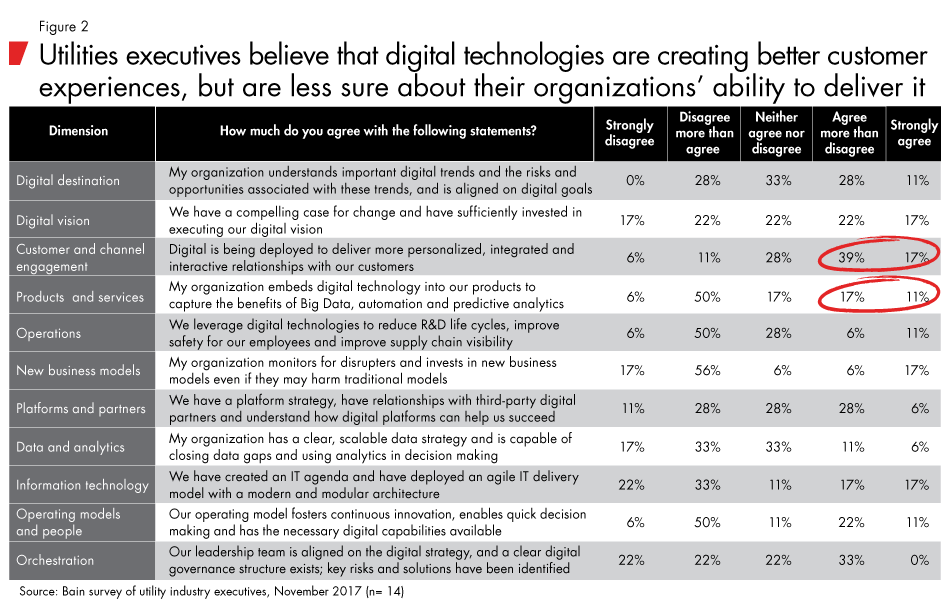
The electricity sector has been slow to change, due to a range of barriers, including its unique regulatory and business model dynamics (see Figure 3). From here on, however, change is likely to accelerate. Traditional boundaries in the value chain are breaking down, even if the regulatory models are slow to reflect that. The cost-of-service economic model, which offers no reward for taking risks or innovating, will have to evolve. Old cultural biases for things developed “in house” will need to give way to a recognition that partnerships and alliances with third parties are necessary in order to gain access to much-needed capabilities.
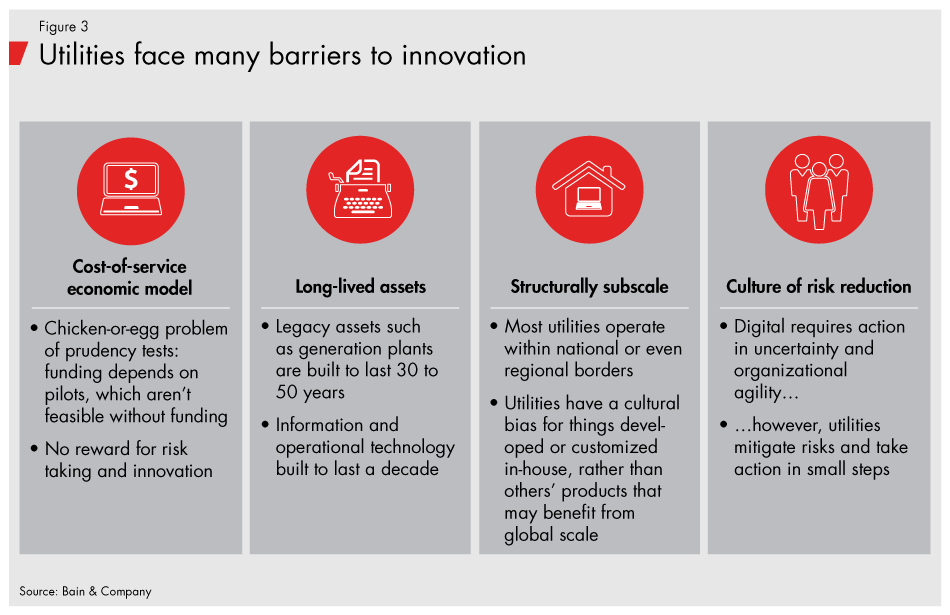
Harness the energy of the entire team
To bring about such radical change, utility teams will need to broaden their thinking about which people and projects to support. When developing digital strategy, most leadership teams have both doers and dreamers. Doers are focused on the here and now. They want to cut through the digital hype and direct the company’s energy toward implementing practical digital initiatives. Because the utilities industry depends on a high degree of confidence and an aversion to risk for capital-intensive and mission-critical investments, the leaders of utility organizations often are pragmatic engineers, who tend to embrace such specificity.
But digital transformations also need dreamers, those who focus on the long term. Dreamers want to define the full set of ways that digital could create opportunities, and they don’t shy away from a chance to become the disrupter. These opportunities for new value are often discovered in the seams between traditional lines of business, places that would be overlooked in a traditional capital-deployment model that depends on established business themes, usually within specified siloes. The perspective of dreamers is critical, but often scarce in utility organizations. To move forward, utilities will have to learn how to tap the insights and energies of these visionaries.
Take concrete steps to build new capabilities, products and services
Most companies are not lacking in ideas about how to put digital technology to work. The challenge is figuring out how to harness those ideas into a coherent set of strategy-based initiatives that can deliver meaningful impact. Digital transformation efforts often founder on the sheer complexity of using technology to increase a company’s speed and learning at scale. Most leadership teams understand the opportunity, but underinvest in the changes to the culture that enable speed, learning and agility. Digital leaders think about their transformations in terms of several broad themes.
-
Chart pathways from digital departure to digital destination. Successful transformations set bold ambitions and build the capabilities to achieve them. Leading teams understand the point of departure, learn where gaps exist and then hire or partner with others to fill them. They invest in analytics capabilities and IT architecture that enable them to develop rapidly and draw meaningful insights from data. Great orchestration boils down to a system that identifies the ideas with the most potential to have enterprise-wide impact and then rallies the organization around them, top to bottom. This requires a coordinated effort at all levels of the corporation—alignment at the top, agility in the middle and mobilization at the front line (see Figure 4).
If this sounds like a recipe for disrupting everything at once, it often is—digital transformation involves change at every level of the organization. However, careful and deliberate orchestration makes the problem manageable. Digital leaders learn to break big ideas down into well-defined waves of practical, achievable stepping-stones that offer steady, incremental progress. They create what amounts to a digital factory that industrializes the process—prioritizing the best ideas, nurturing them, testing them and ultimately scaling them into game changers. Collectively, these waves of innovation build to sustained levels of superior performance over time, allowing the organization to make progress across many fronts simultaneously without overwhelming the organization.
Of all the pathways, utilities often struggle most with platforms and partners, and the operating model.
-
Understand disruptive forces in platforms and partners. Most investment in new energy technologies is coming from outside the utilities sector, including venture capital that is flowing into digital-native, new energy start-ups, particularly in electrification (including development of smart-charging and vehicle-to-grid systems), decentralization (including microgrids and renewable generations), and digitalization (including energy management, customer information systems, and monitoring and security).
Given the low success rates of new ventures, utility executives should continue to outsource early-stage innovation and the risk that accompanies it. They can then forge partnerships, and acquire or license technologies once they are proven. In the UK, Centrica built its connected-home service, Hive, through acquisitions, including deals of 65 million pounds in 2015 to buy AlertMe and 13 million pounds to buy FlowGem in 2016.
-
Evolve the operating model to support a digital utility. Operating models serve as the blueprint for how resources are organized and operated to get critical work done. As executives design the digital strategy of their utilities organizations, they are also reconfiguring the operating model, the organizational design and business processes to support a digital company. The model guides decisions about how people work together within and across the boundaries of the utility; how the center supports the rest of the organization, including field operations; and what norms and behaviors should be encouraged.
Digital and new energy technologies tend to traverse traditional boundaries, wreaking havoc on siloed organizations. Energy storage, for example, is a hybrid: a bit like a peaking plant, while also providing ancillary services and bearing qualities that make it part of the distribution infrastructure. Digital operating models must consider all of this, ensuring that accountability and information flow freely across the organization.
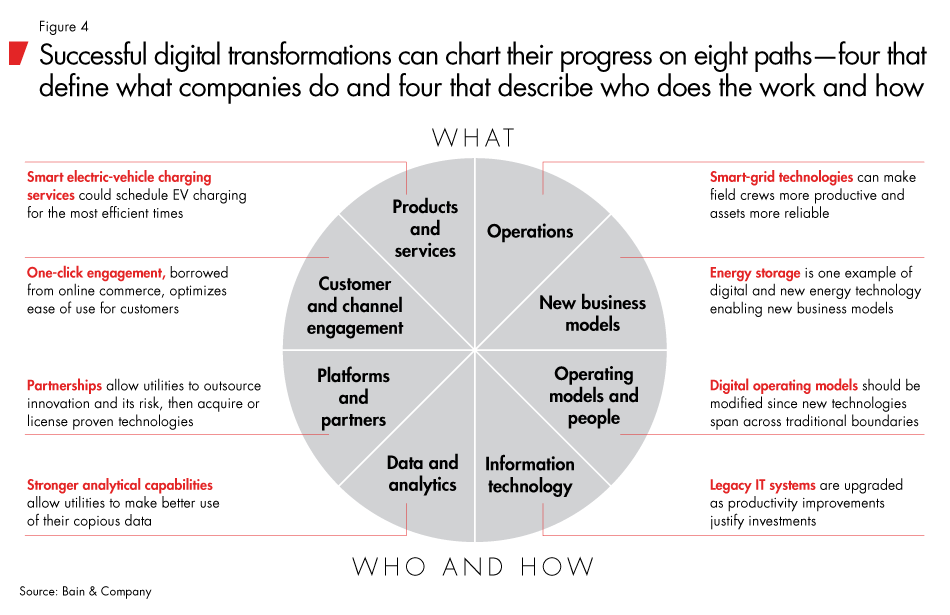
Only a year or two ago, many utilities executives were still sitting on the sidelines, deciding whether and how to advance on digital initiatives within their companies. This is much less common today: Nearly everyone we speak with now recognizes the opportunity and potential value at stake in the broad digital transformation under way in the electricity ecosystem. The most urgent tasks for senior executives today are understanding their point of departure, setting ambitious but realistic targets and moving quickly to capture advantage.
As leaders begin their digital transformation, they can start by taking a hard look at their current position and asking several pointed questions.
- Do we have a clear vision of our starting point and our destination?
- Do we know the impact of digitalization across the entire value chain?
- Have we identified the right partners?
- Do the leaders in our organization understand how to orchestrate this digital transformation across the organization?
Julian Critchlow leads Bain & Company’s Utilities & Renewables practice globally, and Jason Glickman coleads the practice in the Americas. Julian is a partner in Bain’s London office, and Jason is a partner in San Francisco.